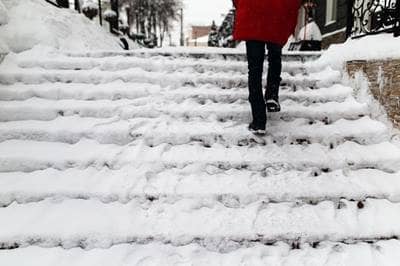Winter slip, trip, and fall hazards

As the calendar year comes to a close and outdoor temperatures begin to drop, the winter season introduces a unique set of hazards. Winter weather, including freezing temperatures, ice, and snow, presents the potential for slips, trips, and falls in many industries. Businessowners that are proactive in managing winter weather hazards are more likely to prevent worker and customer injuries.
Where do winter weather hazards exist?
Depending on a business’s local climate, freezing temperatures can lead to ice and snow accumulation in parking lots, sidewalks, building entryways, and other walking surfaces.
Who is at risk for injury or illness?
Any individual on the premises where ice and snow exist are at an increased risk for injuries due to slips, trips, and falls. This includes employers, employees, customers, vendors, etc.
How can hazards be managed?
- Clear ice and snow in parking lots and on sidewalks regularly
- Obtain a service contract from a professional snow removal company to ensure regular service when ice and snow are present
- Apply anti-slip materials, such as salt and sand, to frozen ground to increase traction when walking on the affected surface
- Provide mats and rugs at interior entryways and frequently used walking paths
- Ensure that mats and rugs lay flat on the ground so they do not present a tripping hazard
- Monitor the floors for spills or the accumulation of melted ice/snow and clean up as needed
- Use wet floor signage to alert patrons of potentially slick areas
- Make sure that all areas accessed by workers or customers are well-lit
- Maintain good housekeeping practices so floors remain free from clutter and debris
- Require that employees wear the appropriate footwear to work, such as slip-resistant shoes
- Train employees on identifying slip, trip, or fall hazards and regularly communicate injury prevention strategies
How can individuals reduce their risk of injury in winter weather?
- Observe your surroundings and be aware of slick walking surfaces
- Take deliberate, short steps or shuffle your feet
- Wear proper footwear for the weather conditions
- Minimize the number of items you carry when walking on ice or snow
- Hold on to railings when using stairs or ramps
- Avoid looking at your cell phone and keep focused on walking safely
For more information on winter weather slips, trips, and falls, visit OSHA’s Winter Weather page at https://www.osha.gov/dts/weather/winter_weather/index.html.
By: Libby Burgher
Risk Solution Services Specialist
Source: Occupational Safety and Health Administration (OSHA)

This "document” is intended for general information purposes and should not be construed as advice or opinions on any specific facts or circumstances. The content of this document is made available on an “as is” basis, without warranty of any kind. This document cannot be assumed to contain every acceptable safety and compliance procedure or that additional procedures might not be appropriate under the circumstances. Markel does not guarantee that this information is or can be relied on for compliance with any law or regulation, assurance against preventable losses, or freedom from legal liability. This publication is not intended to be legal, underwriting, or any other type of professional or technical advice. Persons requiring advice should consult an independent adviser or trained professional. Markel does not guarantee any particular outcome and makes no commitment to update any information herein, or remove any items that are no longer accurate or complete. Furthermore, Markel does not assume any liability to any person or organization for loss or damage caused by or resulting from any reliance placed on this content.
Markel® is a registered trademark of Markel Group Inc.
© 2023 Markel Service, Incorporated. All rights reserved.
